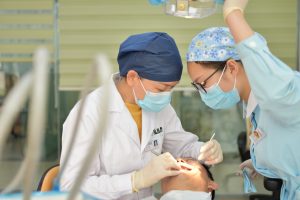6 October 2020
Scottish Dental Association
Working Group on new SDR proposals
Preamble
The Scottish Dental Association (SDA) recognises, along with almost the entire profession and the current CDO, that the pre COVID SDR is not fit for purpose for the likely future situation we face. It should be noted anecdotal evidence suggests most practitioners have felt the previous SDR was not fit for purpose for several years.
To propose potential new solutions the SDA has formed a working group to briefly formulate potential new SDR options.
The SDA welcomes feedback from all sectors within Scottish dentistry on this document and seeks to be part of a wider effort to find a new settlement for the GDS.
Assumptions
We are assuming that the current GDS budget is going to remain roughly the same. The SDA have sought a written answer from the Minister of Health re the current and likely future GDS budget. We are not aware of any personnel within the sector who would expect the future GDS budget to rise.
Given we are assuming the budget will stay the same we have sought to come up with models which will secure both the future of the GDS as widely as possible and allow as much stability for practice owners, associates and the wider industry.
Given the current political situation and our expectation that the Scottish Government (SG) will not want to substantially change the system our models range from very minor changes to the pre COVID SDR to a far reduced service but higher fees per item (the so called “Core Service) to something more akin to the “Global Payments” system associated with General Medical Practice.
What’s next?
We have produced this document as a first step towards a better NHS dental system for all. The current committee of SDA are experienced practitioners who are well aware of how challenging the SDR frequently is, both financially and bureaucratically.
The SDA has no desire to return to the former system, and we believe the majority of dentists feel the same. Similarly, the SDA exists to fight for a fair NHS option and so has no wish to see either a gutless rump of a SDR or something which puts an unfair level of burden on any one group of patients (eg exempt or fee paying) or which doesn’t work for each part of our country.
We believe there is a system to be found which will be an improvement for all in at least some way. This document is a call to all interested parties to contribute to the goal of a better SDR.
New SDR models
Common Principles
Based on the above we felt it was sensible to come up with five different options for consideration. Due to limitations these are not fully costed models however we expect them to be roughly at the same cost of the current GDS.
A very important point is the absolute necessity of some legal or bureaucratic changes we believe are vital if the GDS is to have a future – these are listed in no particular order, then discussed throughout the document.
- The requirement to offer all patients registered on the NHS all SDR options is to be ended.
- There are to be several different contract models which practices could choose to offer, or not. A practice may offer only one model to patients, it may offer all of them. The key is flexibility to allow as wide a number of practices to be able to sign up.
- Any transition phase must be accompanied by support payments in the event the new models adopted results in a drop in practice income. Given income is low already further reductions will inevitably lead to job losses and possible practice failures. If the new models actually do reduce practice income (therefore the GDS budget falls) there needs to be a legally binding way for dentists to change the models to ensure their practices are viable – we are all familiar with the term “clawback” – the SDA believes this principle must be reciprocal.
- The Scottish Dental Practice Board (SDPB) or any successor group must have the authority to recommend changes to the new models to SG. Any new group must be independent of Government and must be chaired by a non employee of SG, preferably an experienced general dentist who is in good standing. The particulars of this group can be agreed later the point is this must the main body overseeing the financial and bureaucratic aspects of the GDS – the Doctors’ and Dentists’ Review Body has not be able to secure the financial improvements dentists actually need vs their cost base and should not form part of future GDS fee settlements. WE need a Scottish body for what is now a very separate system from the rest of the UK.
- Practices shall be guaranteed a minimum contract value over the length of the contract – subject to reasonable conditions/ sanctions, their income shall not fall below this value, providing they are fulfilling their part of the contract as best as they can. In the days of the minimum wage, staff pensions, LDUs, and the many other fixed costs it is no longer acceptable to have a monthly variance down from the required amount needed to at least break even when running a dental practice
- Further, SDA have noted the 100% salary levels of NHS colleagues during the COVID period -regardless of their levels of activity or indeed whether they’ve actually been working at all. Comparing this with the 90% approx. settlement the GDS received we must insist this does not happen again.
- The SDA would propose considering having all options in the any new system or systems free for the patient at the point of use. This would bring dentistry into line with the rest of the NHS – including opticians and pharmacists. At the least, examination and pain relief should be fully covered by the NHS so no patient – regardless of income – pays at the point of need.
The overarching principle is the SDR must move away from a “piece meal” remuneration model – fundamentally unsustainable in the modern context – to a system which secures the services of the dental profession for the nation’s oral health care.
The SDA proposes the following various ways we feel that aim can be achieved but the linchpin of them all is regular, sustainable, fair, and guaranteed funding for dental practices. We seek nothing more than our medical and other colleagues seem to have secured.
Model 1 – The Core Service
Put simply, this model reduces the amount of treatment items the NHS covers but increases the fee level of those items which remain.
Eg Chrome Dentures would be removed from the NHS. The funding they use up per year would be redistributed within the budget to eg acrylic dentures, thereby increasing the fee for acrylic denture work.
Whether or not and how the removed items were then offered to patients would be a matter for practices to decide on
This model is probably the easiest to cost, implement, and explain to patients since the only change is as noted above. The rest of the system would, roughly, remain the same. The principles outlined above need to be followed though as it is feared a core service may still result in treatments being “loss leaders” without the overall budget being increased, eg endodontics.
Some practices could get round this by having a VT offer their core service while the associates offer private dentistry, thereby ensuring the practice is financially viable. Clearly practices without VTs may struggle to offer “loss leading” items of service and so SDA believes practices should be able to offer a core service but shouldn’t be forced into offering every single item of service – it may be a practice would offer a core service for pain relief only and then the rest of what they offer is private. Another practice may choose to be a very basic provider and offer a full core service with a turn up and wait appointment system and the patient seeing whichever dentist is free first. There are various options and ways to make this work – not a one size fits all approach.
A controversial idea but one SDA reluctantly believes must be looked at is the complete removal of any Orthodontic option from the SDR. This would be left to the PDS (which may operate its’ own SDR in future, as it has during COVID) and the HDS through the NHS with the option to go private too.
SDA believes the reallocation of this Orthodontic budget would benefit the oral health of the nation if used appropriately.
Model 2 – The Oral Health Assessment service
This model seeks to highly remunerate an Oral Health Assessment (SDCEP document) type option whereby a patient can receive a detailed exam on the NHS, with the dentist being expected to spend 1-2 hours with the patient at this visit.
The principle of this model is that to secure long-term oral health the patient must understand their own oral and general health and their own behaviours and risks first – before any treatment is considered.
Following on the NHS OHA some items of service might be available on the NHS, that would probably depend on what fee level is used to pay for the OHA. Other items will be private. The point is the patient will know what they need, why, and be educated to look after their own oral health.
Given most oral health problems are preventable this model would seem sensible, in principle. It would be difficult to implement and may result in a decrease in active patients who would be put off by the likelihood of private fees being needed to cover whatever treatment there are advised to have.
The SDA believes this model is worthy of consideration though accepts it would require detailed additional work before it could be launched.
Model 3 – The “Global Sum” service
This model would essentially continue from the principles of the COVID support payments, in that payment would be made as fixed amounts per month.
Where this model would have to differ is:
- Calculation of the global sum. To do so based on historic activity is grossly unfair on practices which have engaged their patients and spend time building relationships with them. It is accepted prevention and education have never been remunerated well under previous SDRs. What has been remunerated well is treatment. Those practices which have historically carried out considerable amounts of lab work etc are receiving (generally) higher support payments. This is unfair and simply doesn’t take into account the fixed costs of eg LDUs which must be covered in any new contract
- The payments must be made to a practice not to the dentist. In the current COVID system some associate dentists are received generally high remuneration levels when their actual activity may amount to a half day triaging phone calls per week. The practice needs the funding and then the principal dentist would be responsible for the overall outcome the practice achieves
This model is an “outcomes” not “inputs” model in that ongoing payment would be assess vs levels of health within the patient base, lack of signs of new disease, etc
It may be this model would work better for practices with already engaged patients who are generally more dentally fit. Perhaps model 1 works better for practices with disengaged patients with high dental needs.
Our point about allowing choice is well illustrated by the above. Some practitioners might prefer the “security” of fixed payments afforded by option 3 whereas those prepared to work longer hours or take on new, dentally unfit patients, may opt for option 1.
Providing there is robust DRO monitoring and auditing (as there should be of course) we would anticipate the right system working in the right setting – again, a one size fits all approach will not work
Model 4 – “Patient Voucher”
This model would give all patients a “voucher” in the form of eg £300 worth of NHS fees per year. This could be used how the patient chooses – it may cover their examination, hygiene visits, and a filling.
One year it could be used towards a new denture but the patient may forgo the hygienist and not need the filling.
The point here is the patient can choose how to spend the level of NHS support and dentists would be free to accept that support or not – some may choose to be fully private and not accept vouchers. Some may only offer treatment on voucher and tailor their practice round that.
SDA understands this system is broadly similar to those in e.g. France and Australia, where patients have what is essentially a State backed or operated insurance system where they can choose from a variety of providers (in France this extends to secondary care as well as primary care) and the State “voucher” covers part of the cost of the care.
SDA believes this system could work very well for some patients and some practices, again subject to checks and balances e.g. patients shouldn’t be encouraged to have unnecessary treatment so the dentist can make £300 off every patient.
It may also act as a good budget control for SG as it is possible, in time, a majority of patients or practices will operate in such a way as to reduce the voucher spend. It may act as a facilitation or access for dental treatment and then the patient ends up not needing to spend £300 per year because they are dentally fit or whatever.
It might be the voucher model would work well for dentally unfit patients who know they can at least have that level of treatment covered per annum.
It also allows practitioners to set their own fees BUT still receive NHS funding. It may be a great help to practices which have stable patient bases but inevitably have higher running costs (e.g. have to pay associates a higher percentage because of recruitment problems) as they know they can persuade patients to “up-spend” beyond the first £300 in most cases, but they have the near certainty that their patients will use the voucher with them
Model 5 – Banding model – “UDA” model
The SDA notes the Welsh NHS dental model is moving to a modified UDA type system and is very interested in the developments there. We are aware of the long standing and severe criticism with which the UDA system is held in England, and possibly Wales, and have no desire to see a copied system here.
However, some sort of banded system e.g. Bands 1,2, and 3 could perhaps be considered – perhaps this is a way to still keep more advanced or costly items in the NHS, e.g. chromes, molar endo, but make it viable for practices to offer them e.g., a band 3 course might be allowable once a year and might be worth £300. A practice and patient may choose to use that band 3 course up on a molar endo and crown. No other NHS treatment would be paid for that year, it would all be private
The particulars of this could be tricky and the whole banding/ UDA system is essentially discredited in the profession’s eyes. However, in the interests of keeping all potential options on the table we are including it here
Conclusion
We hope this document acts as a primer for ongoing dialogue and discussion. We realise a new system will take time to design and implement however it is an urgent priority, the greatest one facing the GDS in the opinion of SDA. Without some sort of workable solution for the future it seems extremely likely many practices will be forced to leave the NHS all together and SDA is firmly against that happening.
Additional final thoughts would include:
- Could dental treatment be made tax deductible somehow to encourage patients to invest in their oral health
- If retaining patient charges should the thresholds/ levels/ exemption categories etc be changed
- How can the profession we consulted on any changes quickly but comprehensively?
- When could a new system realistically be implemented?
- What changes would a new Government in Scotland bring
- What changes will a severe recession in Scotland bring?
- What mechanism would the profession have for terminating the contract should things go wrong in future, e.g. fees be cut as they have been during COVID – could this include a clause for breach of contract to give additional levels of protection to GDS practices?
The Scottish Dental Association Committee









